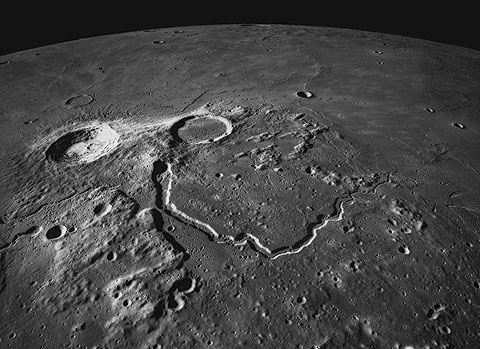Iron core reveals the secret of the Moon
The moon's core is iron! This conclusion was made by René Weber, NASA's Marshall Space Flight Center (USA) and Raphael Garcia, University of Toulouse (France) after dealing with Apollo Program documents in the late 1960s and early 70s of last century.
The Apollo Program on the Moon has set up four seismographs to measure the vibrations of this object until 1977. People have seen seismic collisions on the Moon much less than on Earth. This is because on the surface of the Moon there are many cracks due to its clashes with small cosmic bodies.

The core of the moon is iron
Scientists do not pay much attention to this phenomenon. But after more than 40 years, seismic analysis methods have many big changes. At this time it was discovered that like the Earth, the Moon had a molten metal core. The diameter of that core is about 330-360 km, surrounded by a molten crust of 480 km in diameter. Inside this core is a solid steel block, 240 km in diameter.
Cosmologist René Weber stated: " We used reliable seismic methods to re-examine the data and for the first time obtained direct evidence of the Iron core of the Moon ." With this large amount of iron, the Moon has a strong magnetic field.
According to astronomers, the Moon formed 4.5 billion years ago due to the collision between the Earth and a celestial body, approximately the size of Mars. This impact causes the Earth to break into a large piece, with a molten crust that turns itself into the Moon. Studies of soil composition, conducted in very deep cracks in the Kola Peninsula (Russia) show a coincidence of up to 90% of the Moon's rocky composition.
In 1959, the Moon's magnetic field was determined to be inconsistent. Studies by MIT Institute scientists have demonstrated that at the early stages of existence, the Moon's core is liquid so its magnetic field is similar to the Earth's magnetic field. In addition, because the Moon's crust is also heated and the Moon's interior occurs convection of substances, our natural satellite may have active volcanoes.
Recently, the Japanese exploration ship Kagua detected on the surface of the Moon, not far from the Holma Marius plateau, has a funnel-shaped basin of 65 meters in diameter and about 80 meters deep. That could prove that the Moon once had active volcanoes.
The results of the study were presented at a recent seminar of the American Astronomical Society. Participants all said that the understanding of the Moon's iron core would help us better understand the formation of the Earth and its evolution in the future.
René Weber said: " We will continue to study the Apollo Program data to learn more about the Moon's core and hypothesize to explain what is going on in the following Moon programs. this '.
- The moon also has a liquid-like core like the Earth
- Discover one more layer of the earth's core
- Find out the last ingredient that makes up the Earth core
- The 9th planet has ice-covered iron core
- Revealing the secret half-moon of the Moon
- At the time of dinosaurs, volcanoes on the Moon used to work?
- NASA for the first time revealed the secret
- The elemental secret in the heart of the Earth
- Core Earth originated from supernova?
- The mystery behind the arc reactor in the Iron Man armor
- Decipher the mystery of the Earth's inner core
- Found traces of new forms of iron from the Antarctic universe
 Van Allen's belt and evidence that the Apollo 11 mission to the Moon was myth
Van Allen's belt and evidence that the Apollo 11 mission to the Moon was myth The levels of civilization in the universe (Kardashev scale)
The levels of civilization in the universe (Kardashev scale) Today Mars, the sun and the Earth are aligned
Today Mars, the sun and the Earth are aligned The Amazon owner announced a secret plan to build a space base for thousands of people
The Amazon owner announced a secret plan to build a space base for thousands of people